manual transmission LINCOLN MKS 2016 Owners Manual
[x] Cancel search | Manufacturer: LINCOLN, Model Year: 2016, Model line: MKS, Model: LINCOLN MKS 2016Pages: 382, PDF Size: 3.81 MB
Page 51 of 382

2. Insert a coin into the slot and twist to
separate the housing. 3. Remove the old battery. 4. Install a new batteries with the + facing
downward. Press the battery down to
make sure that it is fully in the housing.
5. Snap the battery cover back onto the transmitter and install the mechanical
key blade.
Car Finder Press the button twice within three
seconds. The horn will sound and
the turn signals will flash. We
recommend you use this method to locate
your vehicle, rather than using the panic
alarm.
Sounding a Panic Alarm
Note: The panic alarm will only operate when
the ignition is off. Press the button to activate the
alarm. Press the button again or
switch the ignition on to deactivate.
Remote Start WARNING
To avoid exhaust fumes, do not use
remote start if your vehicle is parked
indoors or areas that are not well
ventilated. Note:
Do not use remote start if your vehicle
is low on fuel. The remote start button is on the
transmitter.
This feature allows you to start your vehicle
from outside the vehicle. The transmitter has
an extended operating range.
Vehicles with automatic climate control can
be configured to operate when the vehicle is
remote started. See
Remote Start (page
108). A manual climate control system will
run at the setting it was set to when you
switched the vehicle off.
Many states and provinces have restrictions
for the use of remote start. Check your local
and state or provincial laws for specific
requirements regarding remote start systems.
The remote start system will not work if:
• the ignition is on
• the alarm system is triggered
• you disable the feature
• the hood is open
• the transmission is not in
P
• the vehicle battery voltage is too low
• the service engine soon light is on.
48
MKS (CLE) Canada/United States of America, enUSA, First Printing Keys and Remote ControlsE173601 E173602 E138623 E138624 E138625
Page 144 of 382
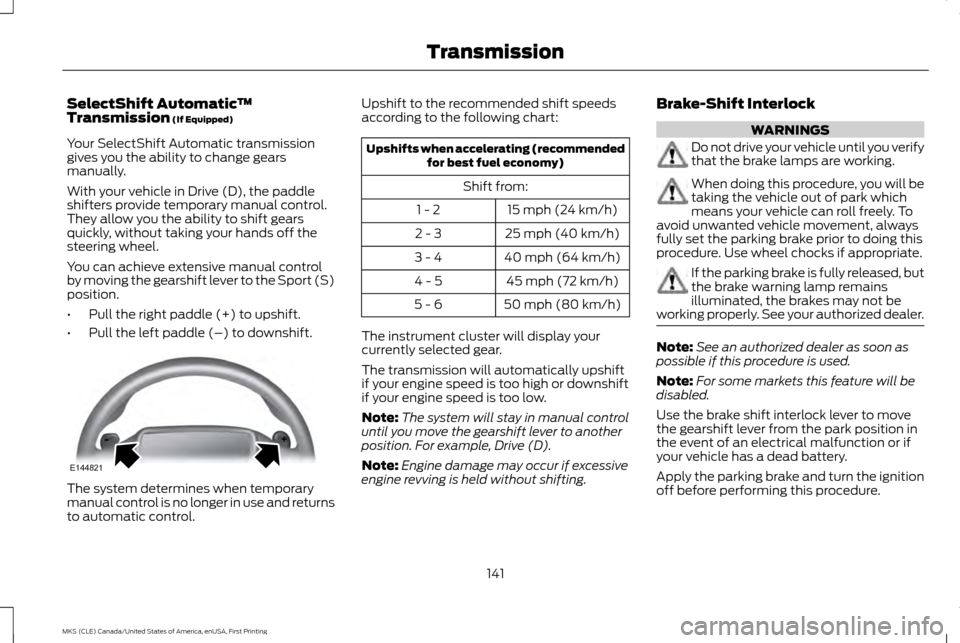
SelectShift Automatic
™
Transmission (If Equipped)
Your SelectShift Automatic transmission
gives you the ability to change gears
manually.
With your vehicle in Drive (D), the paddle
shifters provide temporary manual control.
They allow you the ability to shift gears
quickly, without taking your hands off the
steering wheel.
You can achieve extensive manual control
by moving the gearshift lever to the Sport (S)
position.
• Pull the right paddle (+) to upshift.
• Pull the left paddle (–) to downshift. The system determines when temporary
manual control is no longer in use and returns
to automatic control. Upshift to the recommended shift speeds
according to the following chart: Upshifts when accelerating (recommended
for best fuel economy)
Shift from: 15 mph (24 km/h)
1 - 2
25 mph (40 km/h)
2 - 3
40 mph (64 km/h)
3 - 4
45 mph (72 km/h)
4 - 5
50 mph (80 km/h)
5 - 6
The instrument cluster will display your
currently selected gear.
The transmission will automatically upshift
if your engine speed is too high or downshift
if your engine speed is too low.
Note: The system will stay in manual control
until you move the gearshift lever to another
position. For example, Drive (D).
Note: Engine damage may occur if excessive
engine revving is held without shifting. Brake-Shift Interlock WARNINGS
Do not drive your vehicle until you verify
that the brake lamps are working.
When doing this procedure, you will be
taking the vehicle out of park which
means your vehicle can roll freely. To
avoid unwanted vehicle movement, always
fully set the parking brake prior to doing this
procedure. Use wheel chocks if appropriate. If the parking brake is fully released, but
the brake warning lamp remains
illuminated, the brakes may not be
working properly. See your authorized dealer. Note:
See an authorized dealer as soon as
possible if this procedure is used.
Note: For some markets this feature will be
disabled.
Use the brake shift interlock lever to move
the gearshift lever from the park position in
the event of an electrical malfunction or if
your vehicle has a dead battery.
Apply the parking brake and turn the ignition
off before performing this procedure.
141
MKS (CLE) Canada/United States of America, enUSA, First Printing TransmissionE144821
Page 151 of 382

Note:
Driving through deep water may
damage the transmission.
If the front or rear axle is submerged in water,
have the power transfer unit (PTU) or rear
axle serviced by an authorized dealer. “Tread Lightly
” is an educational program
designed to increase public awareness of
land-use regulations and responsibilities in
our nations wilderness areas. Ford Motor
Company joins the U.S. Forest Service and
the Bureau of Land Management in
encouraging you to help preserve our national
forest and other public and private lands by
“treading lightly. ” Driving on Hilly or Sloping Terrain
Note:
Avoid driving crosswise or turning on
steep slopes or hills. A danger lies in losing
traction, slipping sideways and possibly rolling
over. Whenever driving on a hill, determine
beforehand the route you will use. Do not drive
over the crest of a hill without seeing what
conditions are on the other side. Do not drive
in reverse over a hill without the aid of an
observer.
Although natural obstacles may make it
necessary to travel diagonally up or down a
hill or steep incline, you should always try to
drive straight up or straight down.
When climbing a steep slope or hill, start in
a lower gear rather than downshifting to a
lower gear from a higher gear once the ascent
has started. This reduces strain on the engine
and the possibility of stalling.
If you do stall out, do not try to turnaround
because you might roll over. It is better to
back down to a safe location.
Apply just enough power to the wheels to
climb the hill. Too much power will cause the
tires to slip, spin or lose traction, resulting in
loss of vehicle control. Descend a hill in the same gear you would
use to climb up the hill to avoid excessive
brake application and brake overheating. Do
not descend in neutral; instead, disengage
overdrive or manually shift to a lower gear.
When descending a steep hill, avoid sudden
hard braking as you could lose control. The
front wheels have to be turning in order to
steer the vehicle.
Your vehicle has anti-lock brakes, therefore
apply the brakes steadily. Do not
“pump” the
brakes.
148
MKS (CLE) Canada/United States of America, enUSA, First Printing All-Wheel Drive (If Equipped)E143950 E143949
Page 155 of 382
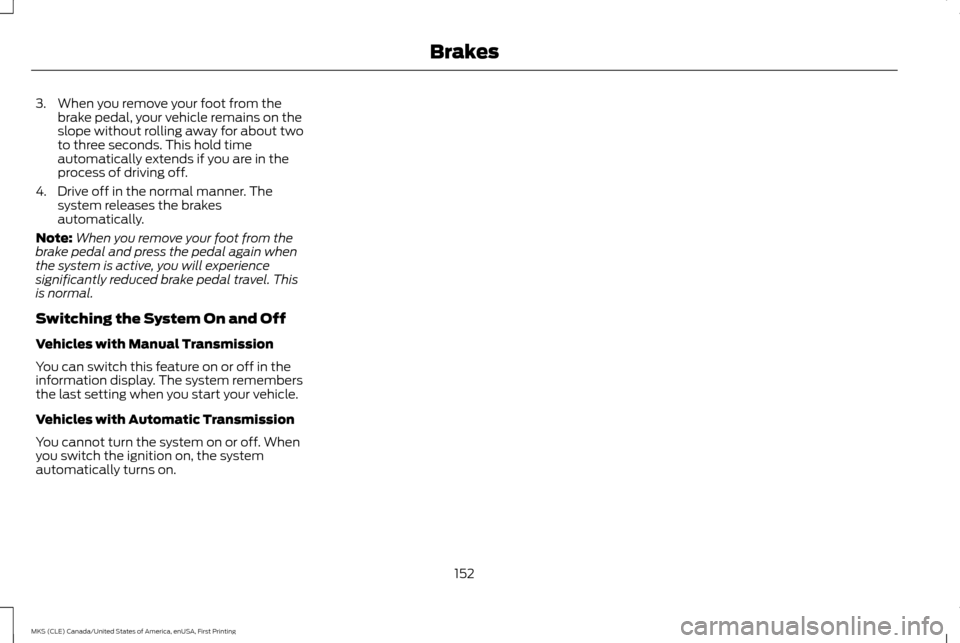
3. When you remove your foot from the
brake pedal, your vehicle remains on the
slope without rolling away for about two
to three seconds. This hold time
automatically extends if you are in the
process of driving off.
4. Drive off in the normal manner. The system releases the brakes
automatically.
Note: When you remove your foot from the
brake pedal and press the pedal again when
the system is active, you will experience
significantly reduced brake pedal travel. This
is normal.
Switching the System On and Off
Vehicles with Manual Transmission
You can switch this feature on or off in the
information display. The system remembers
the last setting when you start your vehicle.
Vehicles with Automatic Transmission
You cannot turn the system on or off. When
you switch the ignition on, the system
automatically turns on.
152
MKS (CLE) Canada/United States of America, enUSA, First Printing Brakes
Page 161 of 382

If the transmission is in drive (D) or any other
forward gear (for example, low (L), sport (S)
or any forward gear in a manual
transmission), the front sensing system
provides audio warnings when your vehicle
is moving below a speed of 7 mph (12 km/h)
and an obstacle is located inside the
detection area.
ACTIVE PARK ASSIST (If Equipped)
WARNINGS
Designed to be a supplementary park
aid, this system may not work in all
conditions. This system cannot replace
the driver ’s attention and judgment. The
driver is responsible for avoiding hazards and
maintaining a safe distance and speed, even
when the system is in use. Active Park Assist does not apply the
brakes under any circumstances.
Note:
The driver is always responsible for
controlling the vehicle, supervising the system
and intervening if required by grabbing the
steering wheel or pressing the active park
assist button (if equipped). Note:
The sensors may not detect objects in
heavy rain, snow or other conditions that cause
disruptive reflections.
Note: Keep the sensors, located on the
bumper or fascia, free from snow, ice and large
accumulations of dirt. Covered sensors can
affect the system's accuracy. Do not clean the
sensors with sharp objects.
Note: The sensors may not detect objects
with surfaces that absorb ultrasonic waves.
Active Park Assist is an electric parking aid
that uses ultrasonic sensors. The system
detects an available parallel parking space
and automatically steers your vehicle into
the space (hands-free) while you control the
accelerator, gearshift and brakes. The system
visually and audibly instructs you to park your
vehicle.
The system may not function correctly if
something passes between the front bumper
and the parking space (a pedestrian or
cyclist) or if the edge of the neighboring
parked vehicle is high off the ground (for
example, a bus, tow truck or flatbed truck).
If you are uncomfortable with the proximity
to any vehicle or object, you may choose to
override the system. The system may not operate correctly in any
of the following conditions:
•
You use a spare tire or a tire significantly
worn more than the other tires.
• One or more tires are improperly inflated.
• You try to park on a tight curve.
Do not use the system if:
• You have attached a bike rack, trailer or
similar object to the front or rear of your
vehicle, close to the sensors.
• You have attached an overhanging object
(surfboard) to the roof.
• The front bumper or side sensors are
damaged or obstructed (front bumper
cover).
• The correct tire size is not in use on your
vehicle (for example, a mini-spare tire).
Using Active Park Assist Press the button to turn the system
on or off.
158
MKS (CLE) Canada/United States of America, enUSA, First Printing Parking AidsE144525
Page 163 of 382

Note:
If a maneuver is interrupted before
completion, the system switches off. The
steering wheel position will not indicate the
actualy position of the steering and you have
to take full control of your vehicle. When you shift the transmission into reverse
(R), with your hands off the wheel (and
nothing obstructing its movement), your
vehicle steers itself into the space. The
system displays instructions to move your
vehicle back and forth in the space.When you think your vehicle has enough
space in front and behind it, or you hear a
solid tone from the parking aid (accompanied
by a touchscreen display message and a
chime), bring your vehicle to a complete stop.
When automatic steering is finished, the
display screen displays a message and a
chime sounds, indicating that the active park
assist process is done. The driver is
responsible for checking the parking job and
making any necessary corrections before
putting the transmission in park (P).
Deactivating the Park Assist Feature
Manually deactivate the system by:
•
Pressing the active park assist button
during an active maneuver.
• Grabbing the steering wheel during an
active maneuver.
• Driving above approximately 22 mph
(35 km/h) for 30 seconds during an
active park search. •
Driving above
22 mph (35 km/h) during
automatic steering.
• Turning off the traction control system.
Certain vehicle conditions can also deactivate
the system, such as:
• Traction control has activated on a
slippery or loose surface.
• There is an anti-lock brake system
activation or failure.
• Something touches the steering wheel.
160
MKS (CLE) Canada/United States of America, enUSA, First Printing Parking AidsE130108
Page 167 of 382
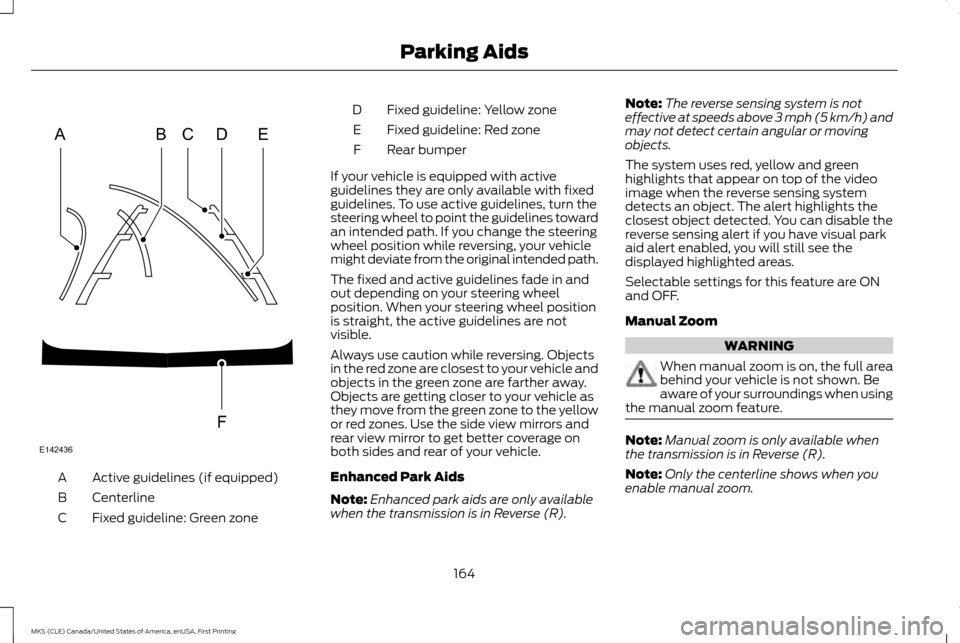
Active guidelines (if equipped)
A
Centerline
B
Fixed guideline: Green zone
C Fixed guideline: Yellow zone
D
Fixed guideline: Red zone
E
Rear bumper
F
If your vehicle is equipped with active
guidelines they are only available with fixed
guidelines. To use active guidelines, turn the
steering wheel to point the guidelines toward
an intended path. If you change the steering
wheel position while reversing, your vehicle
might deviate from the original intended path.
The fixed and active guidelines fade in and
out depending on your steering wheel
position. When your steering wheel position
is straight, the active guidelines are not
visible.
Always use caution while reversing. Objects
in the red zone are closest to your vehicle and
objects in the green zone are farther away.
Objects are getting closer to your vehicle as
they move from the green zone to the yellow
or red zones. Use the side view mirrors and
rear view mirror to get better coverage on
both sides and rear of your vehicle.
Enhanced Park Aids
Note: Enhanced park aids are only available
when the transmission is in Reverse (R). Note:
The reverse sensing system is not
effective at speeds above 3 mph (5 km/h) and
may not detect certain angular or moving
objects.
The system uses red, yellow and green
highlights that appear on top of the video
image when the reverse sensing system
detects an object. The alert highlights the
closest object detected. You can disable the
reverse sensing alert if you have visual park
aid alert enabled, you will still see the
displayed highlighted areas.
Selectable settings for this feature are ON
and OFF.
Manual Zoom WARNING
When manual zoom is on, the full area
behind your vehicle is not shown. Be
aware of your surroundings when using
the manual zoom feature. Note:
Manual zoom is only available when
the transmission is in Reverse (R).
Note: Only the centerline shows when you
enable manual zoom.
164
MKS (CLE) Canada/United States of America, enUSA, First Printing Parking AidsABCD
F
E
E142436
Page 183 of 382
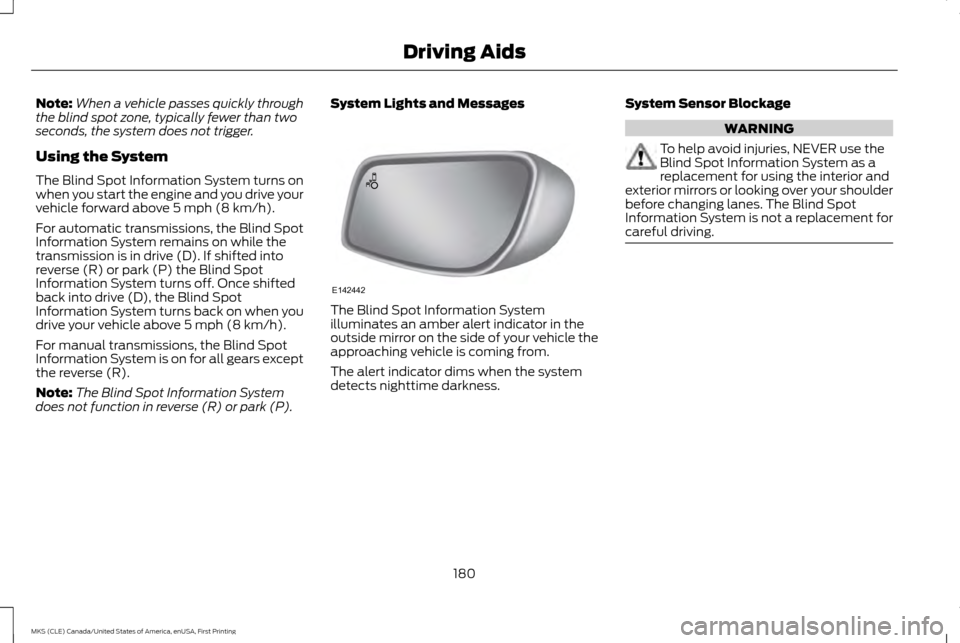
Note:
When a vehicle passes quickly through
the blind spot zone, typically fewer than two
seconds, the system does not trigger.
Using the System
The Blind Spot Information System turns on
when you start the engine and you drive your
vehicle forward above 5 mph (8 km/h).
For automatic transmissions, the Blind Spot
Information System remains on while the
transmission is in drive (D). If shifted into
reverse (R) or park (P) the Blind Spot
Information System turns off. Once shifted
back into drive (D), the Blind Spot
Information System turns back on when you
drive your vehicle above
5 mph (8 km/h).
For manual transmissions, the Blind Spot
Information System is on for all gears except
the reverse (R).
Note: The Blind Spot Information System
does not function in reverse (R) or park (P). System Lights and Messages
The Blind Spot Information System
illuminates an amber alert indicator in the
outside mirror on the side of your vehicle the
approaching vehicle is coming from.
The alert indicator dims when the system
detects nighttime darkness.
System Sensor Blockage WARNING
To help avoid injuries, NEVER use the
Blind Spot Information System as a
replacement for using the interior and
exterior mirrors or looking over your shoulder
before changing lanes. The Blind Spot
Information System is not a replacement for
careful driving. 180
MKS (CLE) Canada/United States of America, enUSA, First Printing Driving AidsE142442
Page 209 of 382
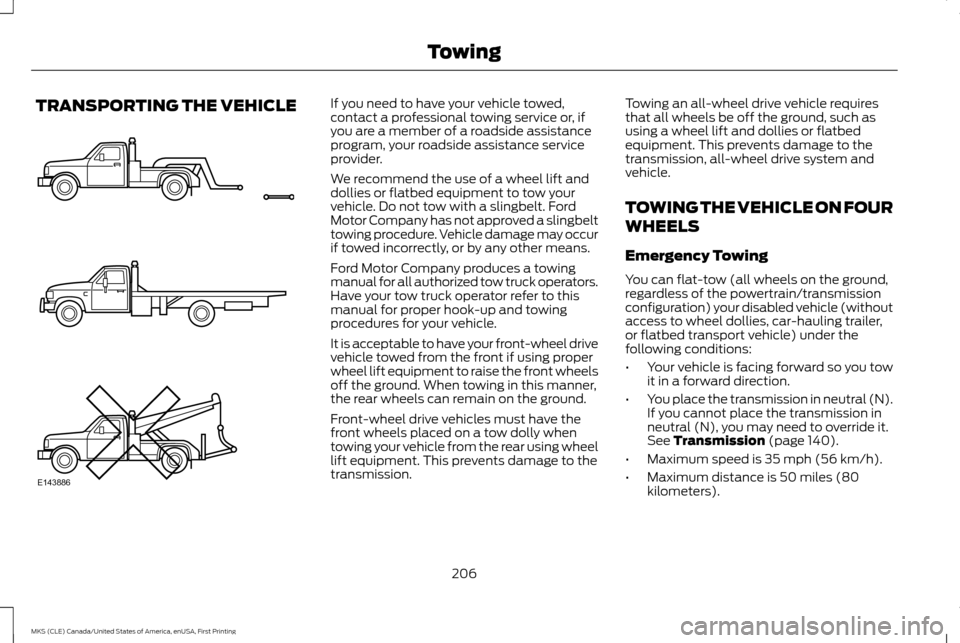
TRANSPORTING THE VEHICLE If you need to have your vehicle towed,
contact a professional towing service or, if
you are a member of a roadside assistance
program, your roadside assistance service
provider.
We recommend the use of a wheel lift and
dollies or flatbed equipment to tow your
vehicle. Do not tow with a slingbelt. Ford
Motor Company has not approved a slingbelt
towing procedure. Vehicle damage may occur
if towed incorrectly, or by any other means.
Ford Motor Company produces a towing
manual for all authorized tow truck operators.
Have your tow truck operator refer to this
manual for proper hook-up and towing
procedures for your vehicle.
It is acceptable to have your front-wheel drive
vehicle towed from the front if using proper
wheel lift equipment to raise the front wheels
off the ground. When towing in this manner,
the rear wheels can remain on the ground.
Front-wheel drive vehicles must have the
front wheels placed on a tow dolly when
towing your vehicle from the rear using wheel
lift equipment. This prevents damage to the
transmission.
Towing an all-wheel drive vehicle requires
that all wheels be off the ground, such as
using a wheel lift and dollies or flatbed
equipment. This prevents damage to the
transmission, all-wheel drive system and
vehicle.
TOWING THE VEHICLE ON FOUR
WHEELS
Emergency Towing
You can flat-tow (all wheels on the ground,
regardless of the powertrain/transmission
configuration) your disabled vehicle (without
access to wheel dollies, car-hauling trailer,
or flatbed transport vehicle) under the
following conditions:
•
Your vehicle is facing forward so you tow
it in a forward direction.
• You place the transmission in neutral (N).
If you cannot place the transmission in
neutral (N), you may need to override it.
See Transmission (page 140).
• Maximum speed is 35 mph (56 km/h).
• Maximum distance is 50 miles (80
kilometers).
206
MKS (CLE) Canada/United States of America, enUSA, First Printing TowingE143886
Page 374 of 382

A
A/C
See: Climate Control.............................................. 105
About This Manual................................................7 Protecting the Environment..................................... 7
ABS See: Brakes................................................................ 150
ABS driving hints See: Hints on Driving With Anti-Lock
Brakes..................................................................... 150
Accessories..........................................................317 Exterior style............................................................... 317
Interior style................................................................ 317
Lifestyle........................................................................\
317
Peace of mind............................................................ 317
Accessories See: Replacement Parts Recommendation......11
ACC See: Using Adaptive Cruise Control.................. 167
Active Park Assist..............................................158 Automatic Steering into Parking Space..........159
Deactivating the Park Assist Feature...............160
Troubleshooting the System................................ 161
Using Active Park Assist........................................ 158
Adaptive Headlamps.........................................75
Adjusting the Headlamps.............................258 Horizontal Aim Adjustment................................ 259
Vertical Aim Adjustment...................................... 258
Adjusting the Pedals.........................................68 Adjusting the Steering Wheel........................65
Easy Entry and Exit Feature................................... 65
End of Travel Position.............................................. 65
Memory Feature........................................................ 65
AFS See: Adaptive Headlamps...................................... 75
Airbag Disposal...................................................45
Air Conditioning See: Climate Control.............................................. 105
Air Filter See: Changing the Engine Air Filter.................. 262
Alarm See: Anti-Theft Alarm............................................. 64
All-Wheel Drive..................................................143
Ambient Lighting
.................................................77
Anti-Theft Alarm................................................64 Arming the Alarm...................................................... 64
Disarming the Alarm................................................ 64
Appendices.........................................................352
Audible Warnings and Indicators..................87 Headlamps On Warning Chime........................... 88
Keyless Warning Alert.............................................. 87
Parking Brake On Warning Chime...................... 88
Audio Control
.......................................................65
MEDIA........................................................................\
.... 66
Seek, Next or Previous............................................ 66
Audio System
......................................................313
General Information................................................ 313
Audio Unit - Vehicles With: Premium AM/ FM/CD................................................................314
Autolamps.............................................................72 Windshield Wiper Activated Headlamps..........72 Automatic Climate Control
...........................105
Automatic High Beam Control.......................74 Activating the System.............................................. 74
Manually Overriding the System.......................... 75
Automatic Transmission
................................140
Automatic Transmission Adaptive
Learning.................................................................. 142
Brake-Shift Interlock................................................ 141
If Your Vehicle Gets Stuck In Mud or Snow........................................................................\
142
SelectShift Automatic ™ Transmission............141
Understanding the Positions of Your Automatic Transmission.................................. 140
Automatic Transmission Fluid Check.................................................................250
6F50/6F55 Transmission................................... 250
Autowipers............................................................69
Auxiliary Power Points.....................................124 110 Volt AC Power Point......................................... 124
12 Volt DC Power Point........................................... 124
Locations..................................................................... 124
AWD See: All-Wheel Drive............................................... 143
B
Battery See: Changing the 12V Battery........................... 255
Blind Spot Information System
....................179
Switching the System Off and On..................... 181
System Errors............................................................. 181
Using the System.................................................... 180
371
MKS (CLE) Canada/United States of America, enUSA, First Printing Index